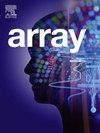An explainable AI-based approach for predicting undergraduate students academic performance
IF 2.3
Q2 COMPUTER SCIENCE, THEORY & METHODS
引用次数: 0
Abstract
The accurate prediction of students' academic achievement has garnered considerable attention in the research community due to its importance in understanding students' progress and assisting them in achieving success. This study presents a novel approach for predicting undergraduate student's performance in the context of Bangladesh. The dataset contains 872 student records from multiple institutions. Initially the dataset was produced utilizing data-preprocessing techniques such as one-hot encoding, column remaining, and managing missing values. SMOTE (Synthetic Minority Oversampling Technique) and normalizing algorithms were employed to attain data balance and feature scaling, respectively. Afterwards, a total of seven distinct machine learning (ML) classifiers, with hyperparameter tuning, were employed to train and test in order to achieve the prediction of students' academic performance. Furthermore, a custom stacking ensemble classifier was utilized, which attained an accuracy of 86.38 %. This classifier outperformed the machine learning classifiers based on the four performance evaluation metrics. Two eXplainable Artificial Intelligence (XAI) algorithms, namely SHAP (SHapley Additive exPlanations) and LIME (Local Interpretable Model-agnostic Explanations), were integrated to provide a comprehensible prediction of the best model and determine the significant factors. This approach provided transparency, fairness and reliability on prediction that improved student performance in the classroom and anticipation.
一种可解释的基于人工智能的预测大学生学业成绩的方法
学生学业成绩的准确预测在研究界引起了相当大的关注,因为它对了解学生的进步和帮助他们取得成功非常重要。本研究提出了一种新颖的方法来预测孟加拉国本科生的表现。该数据集包含来自多个机构的872名学生记录。最初,数据集是利用数据预处理技术生成的,例如单热编码、保留列和管理缺失值。采用SMOTE (Synthetic Minority Oversampling Technique)和归一化算法分别实现数据平衡和特征缩放。随后,共使用7种不同的机器学习(ML)分类器进行超参数调优训练和测试,以实现对学生学业成绩的预测。此外,采用自定义叠加集成分类器,准确率达到86.38%。该分类器在四个性能评估指标上优于机器学习分类器。两种可解释的人工智能(XAI)算法,即SHAP (SHapley加性解释)和LIME(局部可解释模型不可知论解释),被集成以提供对最佳模型的可理解预测并确定显著因素。这种方法提供了透明、公平和可靠的预测,提高了学生在课堂上的表现和预期。
本文章由计算机程序翻译,如有差异,请以英文原文为准。
求助全文
约1分钟内获得全文
求助全文

 求助内容:
求助内容: 应助结果提醒方式:
应助结果提醒方式:


